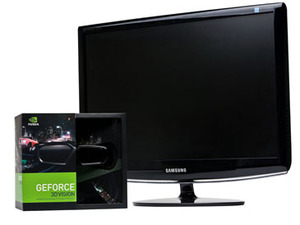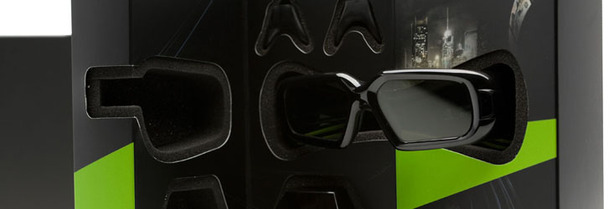
The Kit
As well as the black LC shutter glasses, charged via an included mini-USB cable, there’s also an Nvidia branded USB IR emitter, a ten foot DVI to HDMI cable for use with compatible TVs, a ten foot USB to mini-USB cable, replacement nose pads for the glasses and the usual installation CD and quick start guide, along with a disc of 3D demonstrations.Installing the kit is very simple indeed, with the stereoscopic 3D compatible ForceWare driver installing like any other graphics driver. An easy to follow setup guide followed, prompting us to connect the USB IR control module and then configuring the display and glasses for specific lighting conditions, with simple 3D tests used to make sure all was well and hinting at what’s to come.
Other than the glasses and 120 Hertz monitor the minimum specification for Nvidia’s stereoscopic 3D is remarkably reasonable, and just as with PhysX all you’ll need is a system fitted with a GeForce 8-series GPU or higher. Just as with PhysX though, compatibility is predictably limited to team green, although it wouldn’t surprise us too much if ATI soon revealed it too had been working on a similar 3D solution.
Enabling the in-game Stereoscopic 3D effects is as simple as marking a tick box in the Nvidia driver control panel and launching the games as normal, with required settings for particular games flashing up in green text whenever you start the application. For example, starting Left 4 Dead advised you to disable the film grain and set the in game resolution to the display’s native, and other games make similarly easy requests. Needless to say if you’re confident enough to fit a graphics card setting up stereoscopic 3D should be a doddle. Just remember that a 120 Hertz monitor needs to be connected to your graphics card with full dual link DVI cable, without which the monitor won’t be able to reach 120 Hertz (we tested others and they failed).
One of the stranger options Nvidia has included is that of the 3D crosshair, that the driver is able to superimpose into particular games. Rather than a standard in-game crosshair, which when using stereoscopic 3D appears to hover over all the in game 3D objects along with the game’s HUD and is tricky to focus on, the 3D crosshair replaces standard in game one by becoming a 3D object in its own right. While it might sound odd, it’s much easier on the eyes because your eyes now focus with it into the depth created.
The 3D functionality also supports the playback of specially recorded 3D videos using Nvidia’s own Stereoscopic 3D video player as well as 3D images taken using a stereoscopic lens. You can even take stereoscopic screenshots in game, producing two .jpg images which when combined produce a convincing 3D image.
While the 3D gaming side is obviously very exciting for us, the applications outside gaming are where we see Nvidia’s 3D Vision technology having the biggest influence. Where before scientists, researchers, engineers and designers needed expensive bespoke applications and hardware setups to view data and designs in real time 3D, 3D Vision allows similar results to be achieved using inexpensive core hardware.
In fact, almost all modern 3D engines and displays although expensive and rare right now, will gradually become more and more common place and affordable in the future, so this tech will become less of a reach for everyone over time. Even if it doesn’t have the mass market appeal of a PCI-E graphics card, for those able to make use of it, this technology looks extremely promising.

MSI MPG Velox 100R Chassis Review
October 14 2021 | 15:04











Want to comment? Please log in.